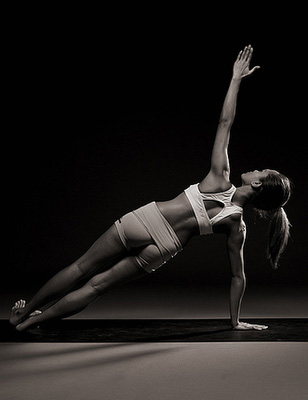It took me about eight years to be able to touch the floor in a standing froward bend. I hope you don't get discouraged by that announcement. It might have taken me less time if I wasn't so obsessed with it. I remember when I started doing yoga again in the 90's, after being away from it for several years. I was tight. I would watch other people come into yoga class and they would be as tight as I was, but then I noticed that they began to get more flexible and I didn't seem to be making any progress. I kept wondering what I was doing wrong. My teacher at the time wasn't that particular about alignment. She wasn't particularly helpful, either. One day she asked me when I was going to get over my hamstring thing! I wished I knew. I thought the day that I would finally be able to touch the floor would be a memorable day for me because I wanted it so bad.
I kept working on my hamstring flexibility by trying harder. I tried so hard that my hamstring attachments at my sitting bones would hurt. I kept irritating them by pushing too hard. One day I finally tore my hamstring. Ouch! I kept practicing, afraid to give up my perceived progress. My sitting bones hurt almost all the time. My physical therapist wasn't much help. I had better range of motion with a torn hamstring than most of his patients would ever hope to achieve. I became even more interested in alignment and anatomy. However, it wasn't until I re-injured my hamstring and ended back in my orthopedic surgeon's office that I started to figure things out. My orthopedic surgeon gave me the best advice for healing my hamstring. I had asked him how could I tell if I was rehabilitating my hamstring or re-injuring it, because when you do physical therapy on an injury, it hurts! This is what he told me:
"When you have an injury, it hurts. Assign the pain you have a number from 1 to 10, with 1 being no pain and 10 being the most pain. So, let's say the pain is a 5 today. When you begin to do your yoga practice, try to keep the pain at the same level. If the pain goes up, don't let it go up by more than 1. When you stop exercising, the pain should return to the same level it was before you started. And (here's where the patience comes in) the next day, your pain should not be any worse."
So, you can only tell if you have gone too far by how you feel the next day! After he told me that, I didn't need too many of those next days where the pain would shoot up to a 7 or 8 to figure it out. I learned to back off, feel what was going on in my body and work smarter, not harder. When I stopped pushing myself so hard, my progress in forward bends developed quickly. I paid more attention to my alignment and to my breath. I cannot remember the day when I was finally able to touch the floor in a standing forward bend because the goal became so much less important than the process.
Are we sensation junkies? Do we push ourselves too hard to feel something? In our effort to feel something, are we not feeling what is already there? Perhaps what we need to feel in our bodies is a greater sense of ease. My Iyengar teacher would say that most students cannot differentiate between pain and a stretch. I know she was right in my case. Where are we trying to get to? What's the rush? Are we so focused on getting somewhere that we cannot appreciate where we are right now? Let me know where you are frustrated. Write in a comment below.
Do you have pain in your body when you are practicing yoga? Are your frustrated with your progress or perceived lack of progress? I would be happy to help you explore these questions. If you are interested, you can always schedule a private with me. Contact me by clicking here.
Several people have expressed interest in learning more about what is going on under their skin while they are doing yoga poses, without having to go through a teacher training program. I am in the process of putting together an experiential anatomy workshop for anyone who is interested in learning more about their anatomy while doing yoga. If this is something that you would be interested in, please leave a comment below. What three things would you like to learn about your body in yoga?


























